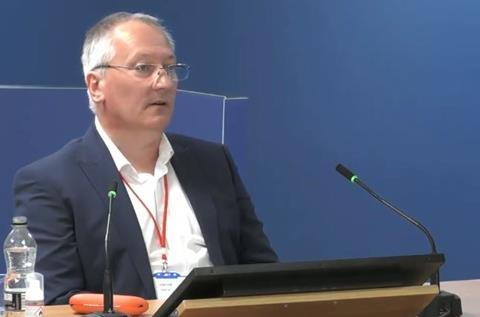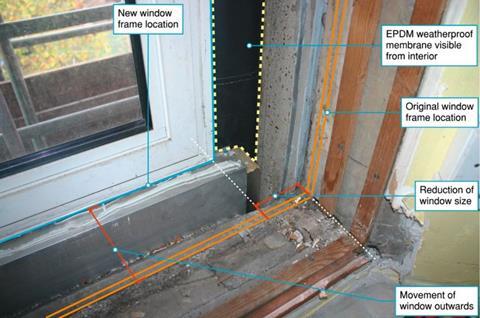Cladding firm’s Harley Facades’ hired hand believed architect’s drawings reflected ‘different route to compliance’
The freelancer hired by Harley Facades to work as “project designer” on the Grenfell Tower refurbishment believed the omission of a key safety feature from architect Studio E’s plans for the scheme was deliberate, the inquiry into 2017’s fire disaster has heard.
Kevin Lamb told the Grenfell Tower Inquiry that he knew the windows of buildings needed to be surrounded by cavity barriers to stop the spread of fire in accordance with Approved Document B of the Building Regulations.

But he told Thursday’s hearing he thought the project architect was using a “different route to compliance” to stop the spread of fire via cavities at windows and took Studio E’s approval of his drawings as confirmation that there was not a problem.
Lamb was brought in to cladding specialist Harley to make up for a staffing shortfall in the summer of 2014, after Rydon was picked as main contractor for the west London tower block and appointed Harley to deliver the façade package for the scheme.
Seventy-two people died when fire engulfed the building in the early hours of 14 June 2017. Combustible aluminium composite material (ACM) cladding and combustible insulation used in the refurbishment have been identified as the main causes of the spread of fire.
However a report by chartered fire engineer and Grenfell Tower Inquiry expert witness Dr Barbara Lane said the lack of fire barriers around windows meant there was a “disproportionately high probability” that if a fire started near a window it would spread into the cladding.
On Wednesday Lamb said that despite his “project designer” title, he had been hired by Harley to act as a drafting service to transfer Studio E’s drawings into fabrication drawings for the external cladding system proposed for Grenfell to be manufactured and installed.
Thursday’s hearing explored how Lamb and Harley approached ambiguity about Studio E’s plans for incorporating cavity barriers into the proposals.
Lamb said he had assumed that the lack of all-around cavity barriers in Studio E’s window plans meant it was pursuing an “alternative route to compliance” with Building Regulations, such as a holistic fire-engineered approach.
“I didn’t give it a vast amount of thought but I did know that the architect was backed up with a fire engineer,” Lamb said. “And we followed the architect’s advice.”
Inquiry barrister Kate Grange QC asked whether he was ever told that that the plan for Grenfell was not to follow the ADB approach. Lamb answered “no”. He added: “I was always told follow the architects’ drawings.”
Lamb said there had been discussions about the cavity-barrier issue within Harley and that he had looked into the requirements of Approved Document B himself as he had been getting “very little feedback”.

Inquiry chairman Sir Martin Moore-Bick asked why, when there was debate about what Studio E’s drawings did actually show, he didn’t seek advice from the architect.
Lamb replied: “I was happy with advice from Harley. They were the cladding specialists, they obviously felt that it wasn’t necessary, or they had discussions. I didn’t know.”
Grange asked Lamb whether Harley could have been keen to avoid the “fiddly” work of installing cavity barriers around the windows and were looking for an excuse not to do it.
“No, that’s definitely not the way they would operate,” Lamb said.
Lamb also rejected the suggestion that Studio E had supplied Harley with early-stage drawings and that it “would have been obvious” to the facades specialist that its job was to develop the design with regard to cavity barriers.
“It wasn’t my understanding that was what we were doing,” he said. “I was told to follow these drawings.”
Lamb subsequently said he was “loosely aware” that drawings he submitted to Studio E were a departure from the guidance in Approved Document B. Asked why more checking wasn’t done, he replied: “I asked Harley what to do and I did exactly what they told me to do.”
He said Studio E had accepted the drawings returned to it from Harley and that was a stamp of approval of the work from the architect.
“By virtue of following drawings, we’ve produced our drawings and he’s approved them,” Lamb said. ”You can expect that he’s happy that there is conformance.”
Lamb was also asked about his role in specifying products used for the Grenfell refurbishment.
He said he had suggested the use of Kingspan Thermapitch TP10 for infill panels between windows. He denied specifying the product, which was combustible and should not have been used.
Lamb said he had not conducted any checks on the material but had been “assured it was a Class O product many, many years ago”. He said he had never seen any British Board of Agrément certificates for the panels.
“I put this to the Harley team as a Class O product and they were happy, and so was the architect,” he said.
Under further questioning, Lamb said he had not considered that the product may have had combustible material inside and be unsuitable for use on external walls of a building above 18m in height.
“It was offered to the team,” he said. “Harley’s got far more experience of this kind of thing than myself, as has the architect.”
Regulations ambiguity
At the end of her questions, Grange asked Lamb what he would have done differently on the project knowing now how it turned out.
”Without the luxury of hindsight, and just considering that I was a freelance design resource, I don’t think that there was anything different that I could have done,” he said.
”However, it’s quite clear from a lot of our conversations that there’s a total lack of clarity in the regulations that everyone’s supposed to adhere to.”
He concluded: “I really think something needs to be done just to take the ambiguity out of the documentation that everyone’s supposed to conform to.”
The inquiry continues.










No comments yet